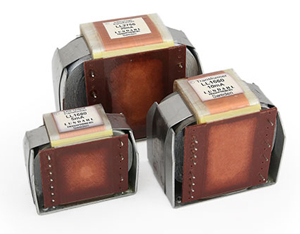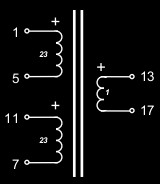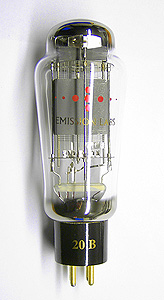Saving the world from Solid State
Design Notes for 12B, 20A, 20B, 20B-V4, 30A
Description
This series of tubes are made for higher gain. Compared to (classical) low gain triodes, any higher gain tube operates at somewhat higher voltage, and lower current. It does not mean, the tubes can not be used at lower voltage, in fact they work remarkable good, just in that case signal output swing will be accordingly lower. Application range is very variable, and many interesting designs are possible.
Miniaturization of tubes, is always on the cost of less nice tube curves. This makes miniaturized tubes develop a lot of distortion at large signal swing. For this simple reason, we prefer our larger anode systems. So here, at high signal, high gain, these tubes come really alive, still at low distortion.
Gain of 12B is appr 14x, 20A/20B is appr. 20x, and 30A is appr. 30x. Depending on the tube type, they can be used as driver tube, pre-Amp Output, Head Phone, Classic speaker amplifier, or OTA amplifier. Please note, tube gain is always specified "unloaded" in data sheets. The unloaded gain will be achieved, if choke loaded, or with an inter stage transformer. In an speaker output stage, the tube is always loaded with the primary impedance of the output tranformer, causing the gain drop, depending on the application.
Some unique applications are possible such as the OTA amplifier, ot the SAKUMA principle. OTA stands for One Tube Amplifier. Such a complete amplifier works with only one tube. Such an amplifier uses a step up transformer at the input, and this gives already enough signal to drive the 20B, which by itself needs not much input signal, because of it's high gain. Sakuma is the name of a Japanese designer, who used this method in many of his amplifiers. By the Sakuma method, the output stage is driven by an identical stage, and 2nd harmomics of the one stage is eliminated by the other.
Applications |
|||||||
ANODE TYPE |
Driver tube |
Line Out |
Speaker Output |
OTA |
Head Phone |
Sakuma |
|
12B |
Black Powdered | Yes |
Yes |
Yes |
. |
Yes |
|
20A |
Mesh | Yes |
Yes |
. |
. |
. |
|
20B |
Black Powdered | Yes |
Yes |
Yes |
. |
||
20B-V4 |
Black Powdered | Yes |
Yes |
Yes |
Yes |
||
30A |
White Powdered | One single tube for the first stage and driver | |||||
Why recommend Lundahl transformers We think these have the best relation between price and performance, and product portfolio is huge. The quality is hidden, such a frequency range is specified, driving it by signal source with impedance, same as a tube. The Japanese specify their transformers, driven with a zero ohms source, which is to my opinion fake, because it makes frequency curve look a lot nicer as it really is. Moreover, efficiency of the Lundahl in unbeaten, as they produce their own steel cores. Given what an amplifier costs, it is not a good idea to use a higher loss output transformer, just to save 30 Euro. We think these have the best relation between price and performance, and product portfolio is huge. The quality is hidden, such a frequency range is specified, driving it by signal source with impedance, same as a tube. The Japanese specify their transformers, driven with a zero ohms source, which is to my opinion fake, because it makes frequency curve look a lot nicer as it really is. Moreover, efficiency of the Lundahl in unbeaten, as they produce their own steel cores. Given what an amplifier costs, it is not a good idea to use a higher loss output transformer, just to save 30 Euro. |
|
 |
SPEAKER OUTPUT APPLICATIONLL2735B. Specially designed for us, by Per Lundahl. Such a perfect transformer for the EML20B!The specialty: When using an 1:4 input transformer, it is possible to build a complete SE amplifier with just one tube. Such concept is called One-Tube-Amplifier (OTA). We have a programmable (1...4x) gain PCB for this purpose, using LL1544A. . Some Examples of OTA amplifiers Pic1 - Pic2 Designed for 20B, this transformer works also on 12B. When using 12B, you need a driver tube in addition, but not the step up input transformer any more. |
CHOKE LOADED APPLICATIONThis gives the best electrical performance. The only load is the capacitance of the following tube, and also it's grid to ground resistor. These are generally high values, and the tube works almost in the "unloaded" range. This will result in higher gain, and most of all in very low distortion, even at highest signal, because the load line is horizontal. (Example here). This keeps the signal swing away from the bottem right part of the curves, which is where the distortion occurs. |
|
 |
INTERSTAGE APPLICATIONFor 12B, 20A, or 20B, we recommend Lundahl inter stage LL2756. 20A or 20B can be used 1:1. 12B can be used 1:1 or 1:2 step up With this 1:2 inter stage, and an additional 1:2 INPUT transformer this will be a one-tube driver system, for tubes like 300B, 45 or 2A3. Thus bringing down noise, hum, and distortion to an incredible low level as not possible otherwise. This is because the first tube (as in a 3-tube triode amplifier) is not used. The first tube however is the main source of hum and noise. We recommend the programmable (1...4x) gain PCB for this purpose, using LL1544A |
 |
Line Out ApplicationFor 12B, 20A-Mesh or 20B, we recommend Lundahl LL1689. If used as line output transformer, LL1689should be wired 18:1 for all 20B versions, or 9:1 for the 12B. Doing so, will make the line out stage dead-quiet. |
12B Some operating points.This is AC heated. If DC heated, Grid voltage shifts 2.5 Volt. (See Notes) | |||||||||||
Anode Voltage | Grid Voltage |
Input |
Cathode resistor for Auto Bias |
Anode Current (mA) |
Gain |
Anode Rp (Ohm) |
Anode Load |
Lundahl Trans former |
Output |
Tube Dist. Total |
Use as |
430V See Chart |
-20.9V |
4.1V RMS |
831R |
25mA |
14.6 |
3k1 |
Choke or inter stage |
LL1668-25mA |
60V RMS |
0,03% |
Driver Stage
|
430V See Chart |
-15V |
10,7V RMS |
257R |
58mA |
10 |
2k3 |
5k |
LL1663-60mA |
2,2Watt |
1.4% |
Output Stage |
-15V |
10,7V RMS |
257R |
58mA |
10.8 |
2k3 |
6k5 |
LL9202-50mA |
2Watt |
0.9% |
Output Stage |
|
500V See Chart |
-21.1V |
14,9V RMS |
422R |
50mA |
10 |
2k4 |
5k |
LL1663-50mA |
4,1Watt |
3,3% |
Output Stage |
500V See Chart |
-21.1V |
14,9V RMS |
420R |
50mA |
10.5 |
2k4 |
6k5 |
LL9202-50mA |
3.8Watt |
2.1% |
Output Stage |
| As a driver stage, most power tubes like 300B, need appr 60V RMS on the grid. Using 12B as a driver, only 4.1V is needed. This can be achieved with a 4x step up transformer, which gives this gain free of noise and microphonics, and supplies even a balanced input. | |||||||||||
20A Some operating points | |||||||||||
Anode Voltage | Grid Voltage |
Input RMS |
Cathode resistor for Auto Bias |
Anode Current (mA) |
Gain |
Anode Rp (Ohm) |
Anode Load |
Lundahl Trans former |
Output |
Tube Dist. Total |
Use as |
350V See Chart |
-12.6V |
3.14V |
1263 |
10mA |
20.8 |
5k4 |
Choke loaded |
LL1668-10mA |
60V RMS |
0,17% |
Driver Stage |
| As a driver stage, most power tubes like 300B, need appr 60V RMS on the grid. Using 20A as a driver, only 3.14V is needed. This can be achieved with a 3x step up transformer, which gives this gain free of noise and microphonics, and supplies even a balanced input. | |||||||||||
20B Some operating points | |||||||||||
Anode Voltage | Grid Voltage |
Input RMS |
Cathode resistor for Auto Bias |
Anode Current (mA) |
Gain |
Anode Rp (Ohm) |
Anode Load |
Lundahl Trans former |
Output |
Tube Dist. Total |
Use as |
350V |
-8.3V |
414R |
20mA |
19.3 |
4k9 |
16k |
LL2735B |
0,5Watt |
0,92% |
Driver Stage |
|
521V |
-12,2V |
254R |
48mA |
16.6 |
2k9 |
11k |
LL9202-50mA |
1,8Watt |
1% |
Output Stage |
|
580V |
-15.7V |
368R |
43mA |
16.5 |
3k |
6k5 |
LL9202-50mA |
3,59Watt |
3.7% |
Output Stage |
|
30A Some operating points | |||||
Anode Voltage | Control Grid Voltage
|
Anode Current (mA) |
Trans-
|
Anode Rp (Ohm) |
Gain
|
300 |
-3 |
10 |
4.6 |
8k |
36 |
300 |
-2 |
15 |
5.3 |
6k6 |
35 |
300 |
-1 |
20 |
5.5 |
5k9 |
33 |
.
| |||||
360 |
-5 |
10 |
4.4 |
8k |
36 |
360 |
-3.8 |
15 |
5.1 |
6k9 |
35 |
360 |
-2.8 |
20 |
5.7 |
6k |
34 |
360 |
-2 |
25 |
6.2 |
5k6 |
34 |
360 |
-1.1 |
30 |
6.6 |
5k1 |
34 |
. |
|||||
420 |
-6,7 |
10 |
4.3 |
8k5 |
36 |
420 |
-5.6 |
15 |
5.0 |
7k |
35 |
420 |
-4.6 |
20 |
5.5 |
6k |
33 |
. |
|||||
480 |
-8.6 |
10 |
4.1 |
9k3 |
38 |
480 |
-7.5 |
15 |
4.9 |
7k2 |
35 |
480
|
-6.5 |
20 |
5.5 |
6k3 |
35 |
- AC heated vs. DC heated. Historically, tube charts were always made AC heated. If DC heated however, the same tube will off-bias with 1/2 of the heater voltage if charts are drawn. This is not important by itself, only we need be aware of this. For tubes with very high grid voltage like 520B has 100V, it was less important because tolerance on grid voltage is higher than that anyway. For tubes with only 6 Volts grid voltage, 1/2 of the heater voltage does make quite a difference. So for such tubes ( higher gain tubes) this becomes important to know. As a rule of thumb, you can recognise AC heated curves by the zero volt Ug line, starting at zero plate Volt and zero plate current. If DC heated, the 0V (diode curve...) looks like the -2.5V curve of AC heated curves. This is so, because all curves are 2.5V shifted. We made the working points here AC heated. This is just to avoid a mess, because design theory, assumes AC heating. However, you probably use the tube DC heated, and we even recommend this. This makes no difference for the use, only the circuit works with 2.5V shift in grid voltage. Take this into account when choosing the bias resistor and the grid voltage. For example, if the AC heated, the grid voltage is -25V, then if DC heated, you will see the tube needs -22.5V. To achieve this -22.5V, the grid resistor must be chosen lower with a factor 25/22.5.

